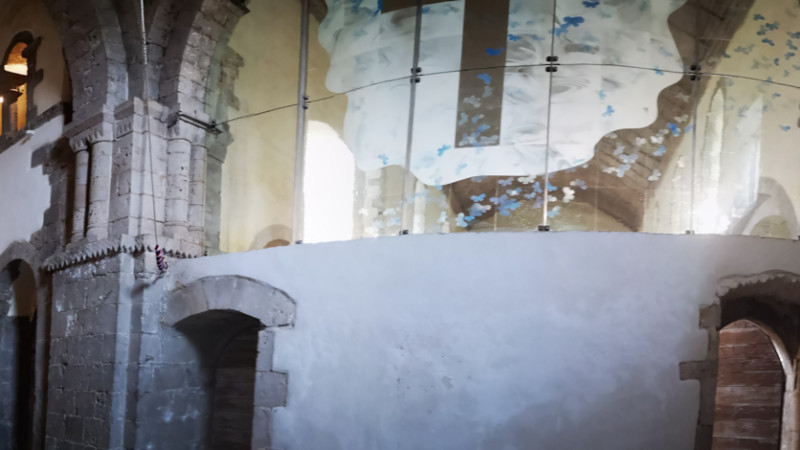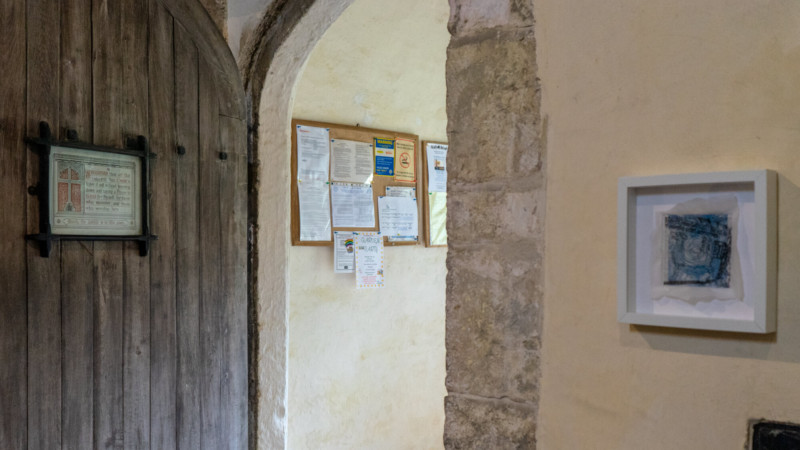ART IN SOUTH WALES – EXHIBITION: Re-Making Maps of the Mind: Medieval and Modern Journeys
in Ewenny Priory – Church of St. Michael and All Angels, Parish of Glamorgan Heritage Coast
Art in Ewenny Priory – Saturday 30th June 2019 – 17 August 2019
The St Thomas Way
St Thomas Way is a modern pilgrimage trail from Swansea to Hereford, inspired by the medieval story of William Cragh. He was hung in Swansea in 1290, but miraculously came back to life. He was sure he’d been saved by Thomas, the late Bishop of Hereford and walked barefoot from Swansea to Hereford Cathedral to say ‘thank you’.
“Measuring to the Saint”
In those days, it was common practice to measure the bodies of the sick, needy or dead, by running a length of string or thread from the top of a person’s head to the tip of their toes. This length would be curled up and sent to the nearest cathedral or priory, where the monks would make it into a candle, light it, and then pray for the person’s eternal soul.
It was when he was being measured to the saint that William came back to life. The idea that something as humble as a simple piece of string might connect this world and the next, or be able to spark life into our very souls, inspired artist Michelle Rumney, to use the medieval practice of ‘Measuring to the Saint’ as a starting point to create this exhibition for the launch of St Thomas Way at Hereford Cathedral (July 2018).
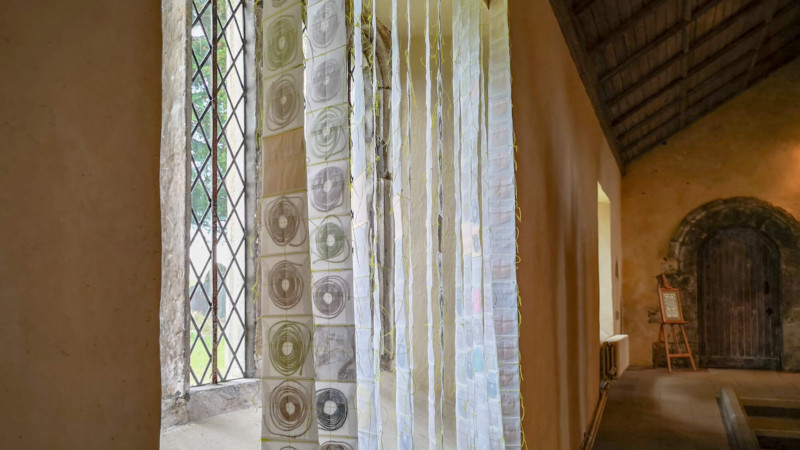

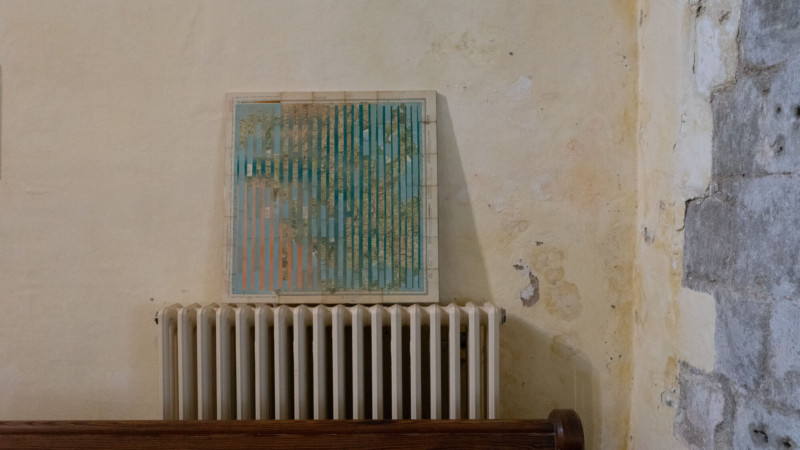
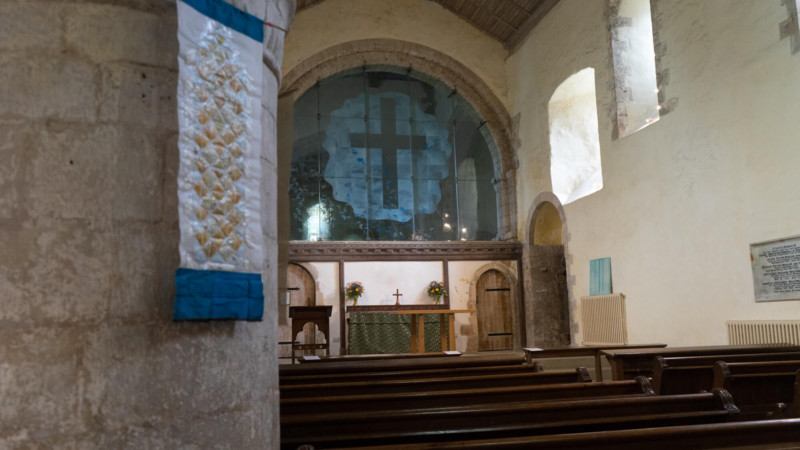
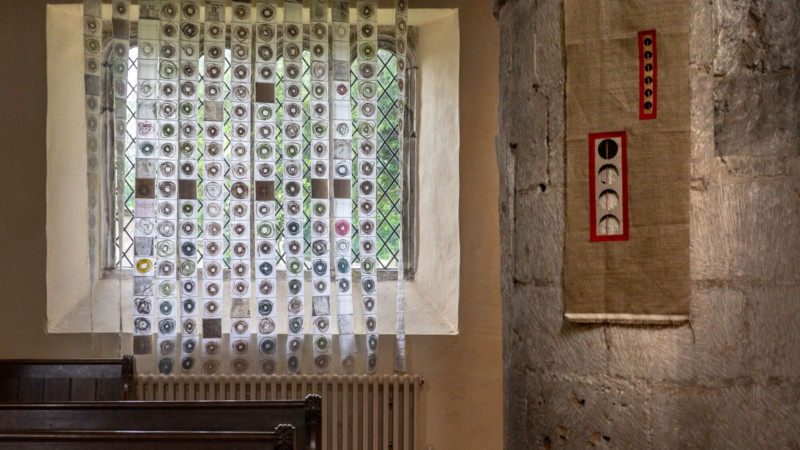
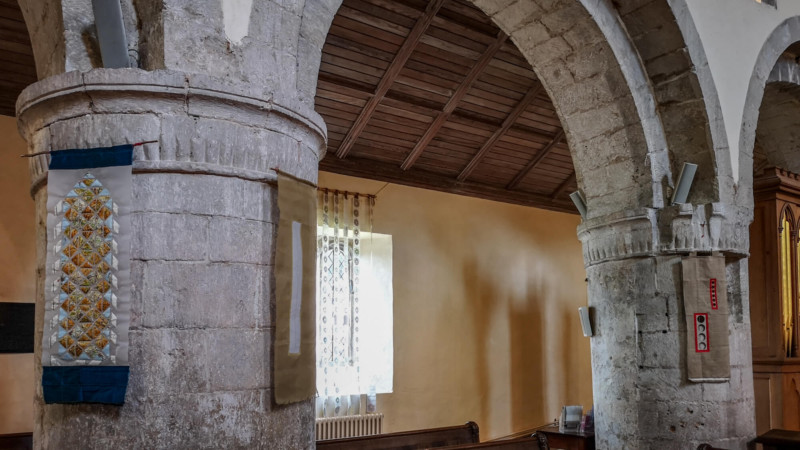
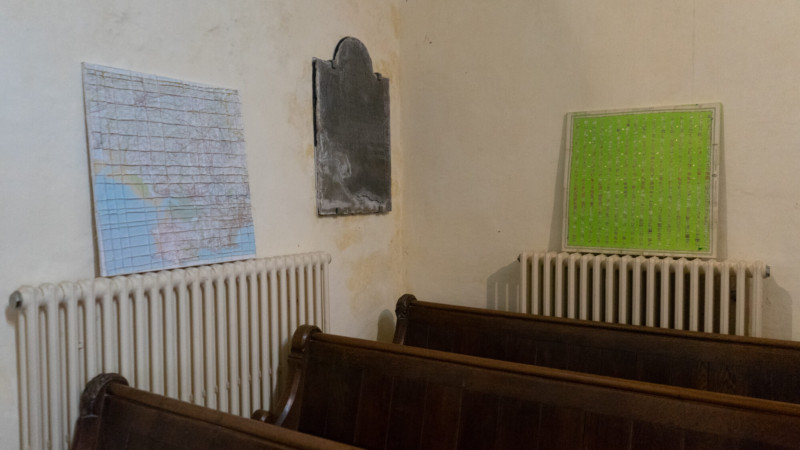
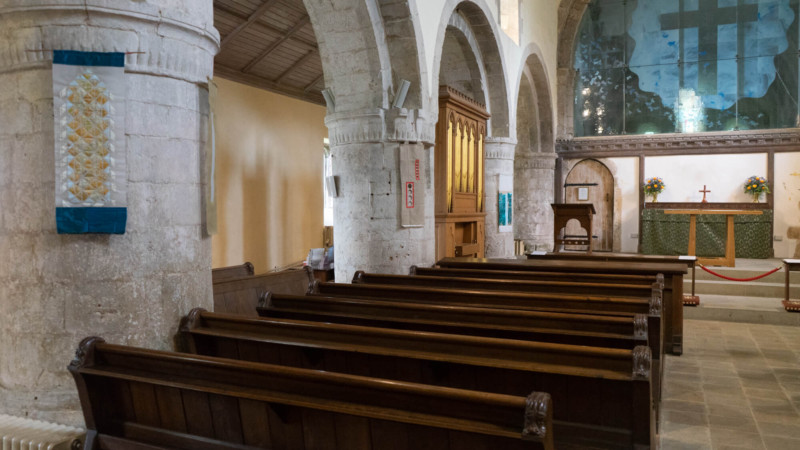

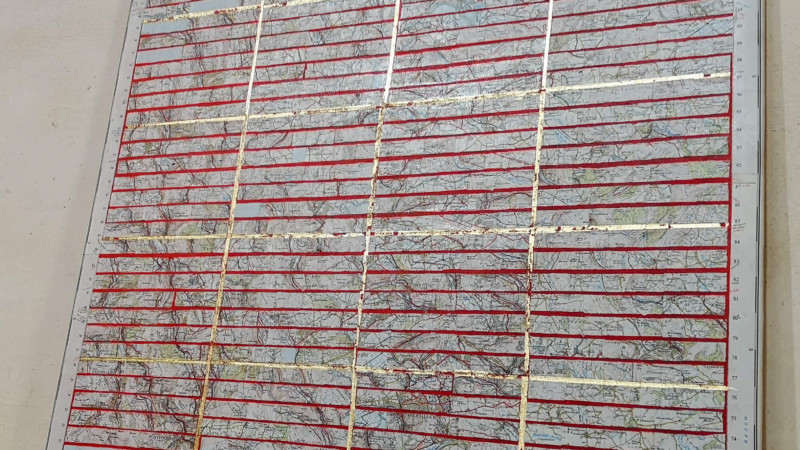
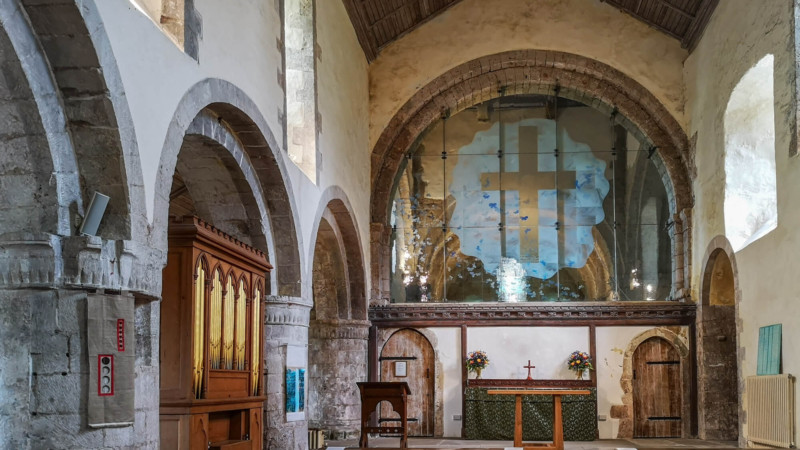
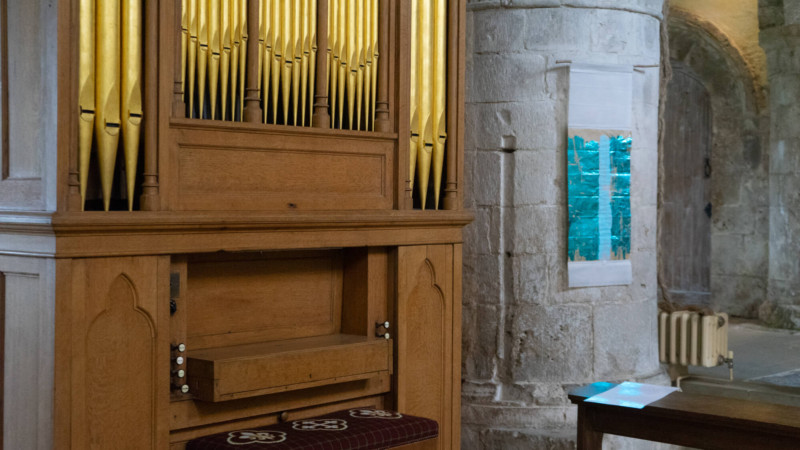
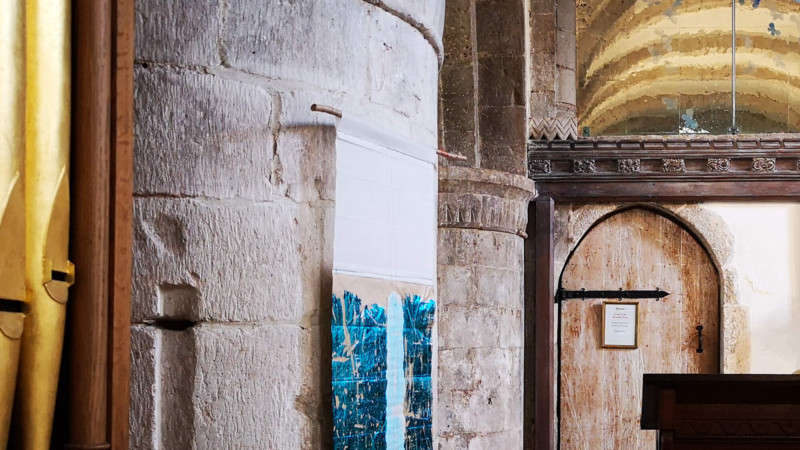
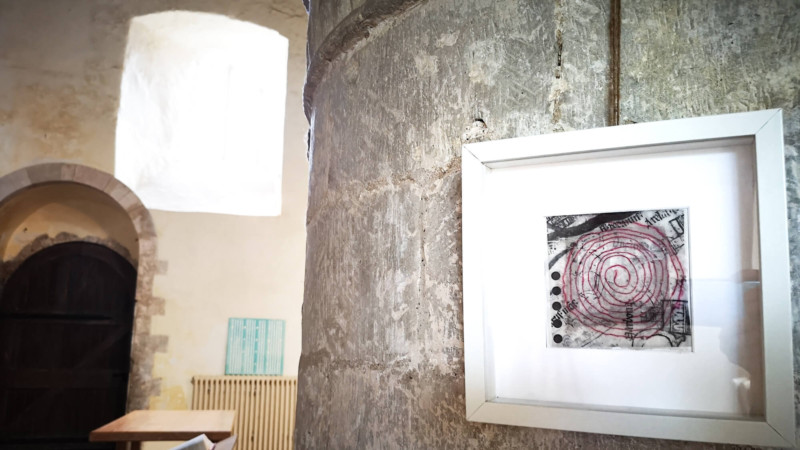

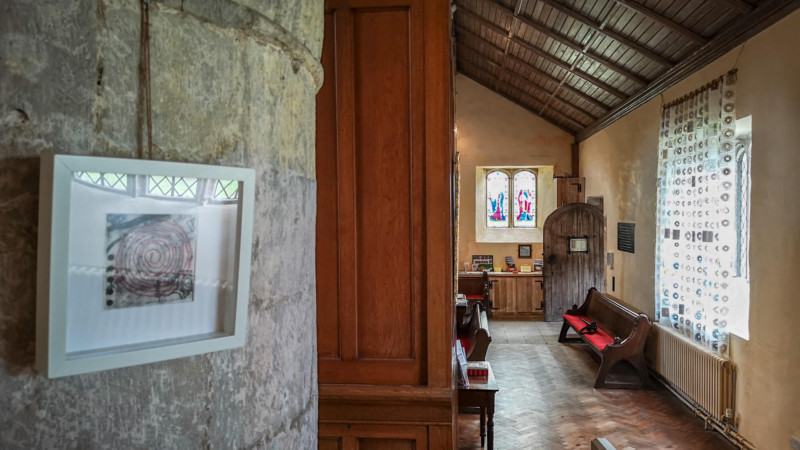
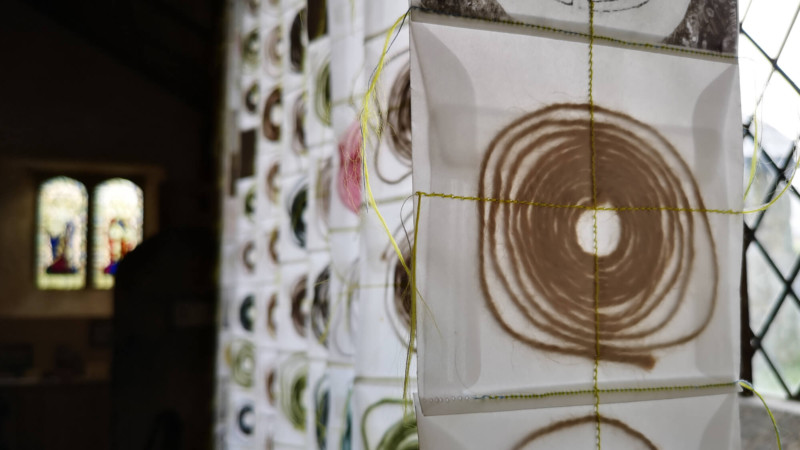


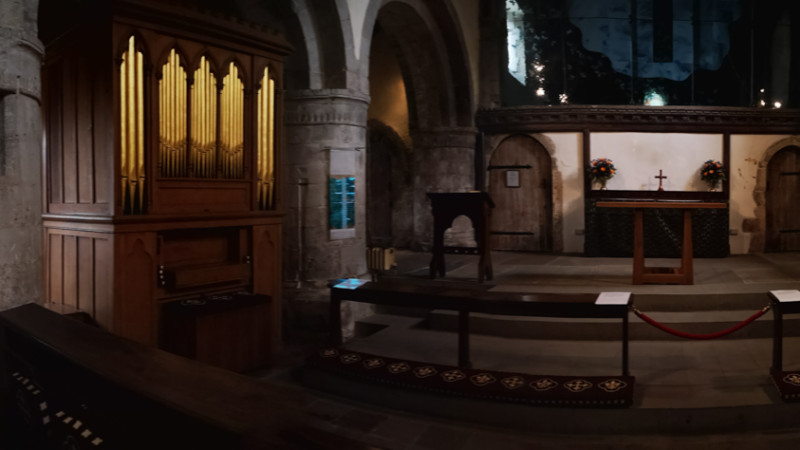
Hanging in the window in the side aisle: ‘The Map of Mundi’
Michelle used the medieval practice of ‘Measuring to the Saint’ to create this large artwork. Telling the tale of William Cragh as she went, she measured over 250 people (and one great dane and a teddy bear) with string. In her studio she coiled each string into a spiral, She stitched a cross over each one, before stitching them together.
She also measured Hereford Cathedral’s Mappa Mundi, the largest surviving medieval map of its kind. It’s a wonderful account of how people saw the world around them, and it was used more as a storytelling tool than a map as we know might know it today. The artist has included details of people, places and animals from a Mappa Mundi view of the world in the artworks here, as well as details from maps we’re more familiar with in our ‘modern’ way of looking at things.
When they finally arrived at St Thomas’ shrine at Hereford Cathedral, pilgrims would stop beside the map and gaze at this fantastical world whilst guides would tell them stories about the characters and places in it, some from the Bible, and others, from myths and medieval folklore. This was part of the pilgrimage experience, widening their personal understanding of the world as they knew it…
“Change the way you look at things and the things you look at change…”
In this contemporary ‘Map of Mundi’ there are 13 vertical strips, one for each waypoint on St Thomas Way and in all, there are 286 squares.
Some squares have been left empty deliberately and the piece is transparent so that you can glimpse through into another time and space – both in this wonderful priory and in your own imagination.
If you’ve travelled along any part of St Thomas Way – or are about to – take a moment now to pause with your fellow ‘pilgrims’ – the ones physically present in the spirals in this ‘map’ – and also with the thousands of people over the centuries who’ve been present right here where you are now on their own journey…
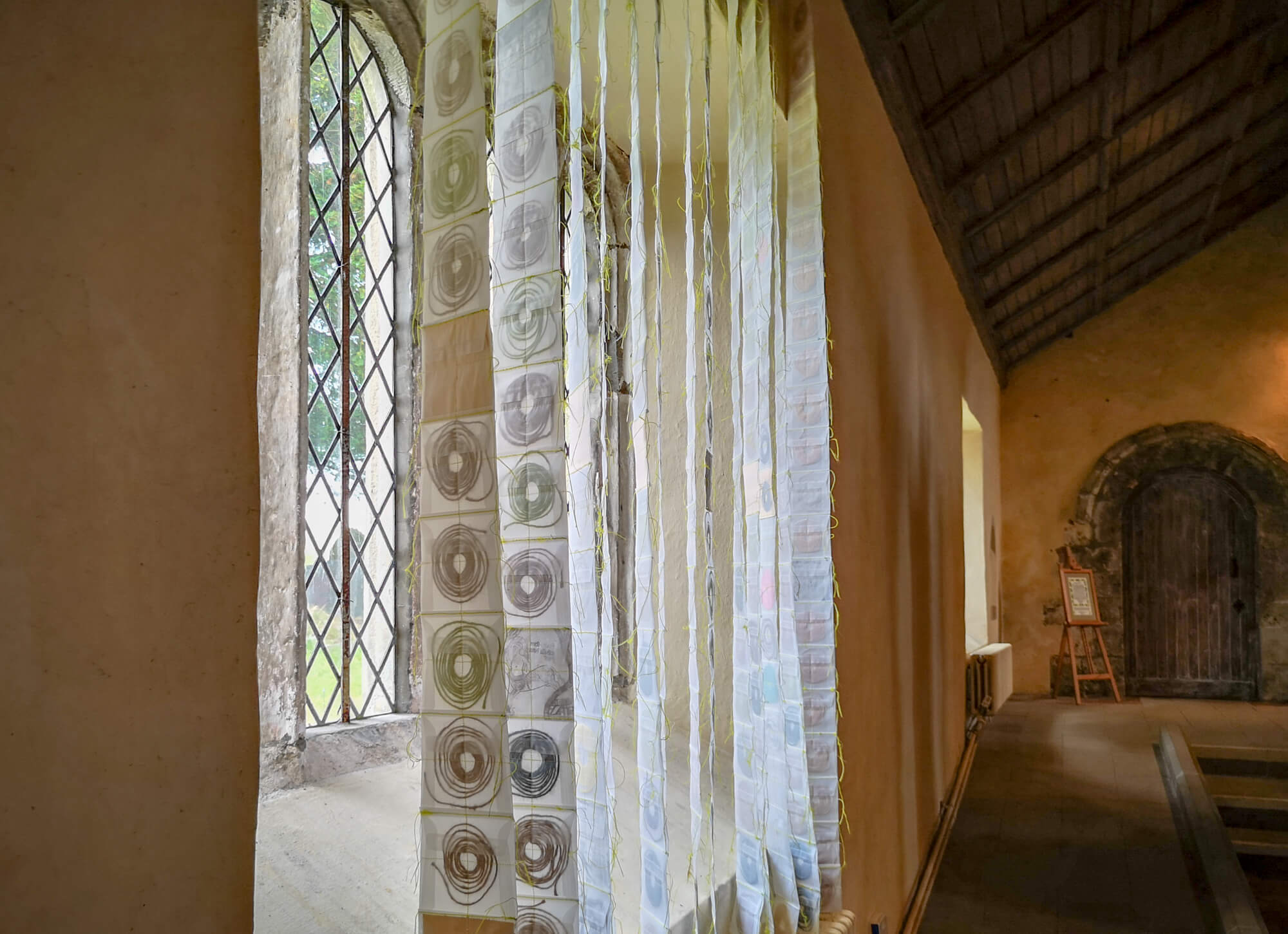
Exhibition Mini-pilgrimage
Begin by the table on the right of the entrance, then go on into the main church, up the towards the altar, and back again along the side aisle by the windows.
1. ‘Strip Map: St Thomas Way’
map pieces & stitching on paper on tapestry gauze
In the 17th Century, mapmakers like John Ogilby made maps for journeys helping travellers get from A to B. These ‘stripmaps’ showed the route as a straight line, rather like Google Maps does now. This strip map is the route of St Thomas Way, made from paper maps – never quite a straight line, but all the more interesting for it.
2. ‘Window Map’ (on column)
map pieces & glue on tracing paper
Triangulation is an important map-making tool, invented in 1533 by Gemma Frisius, which emerged from Islamic mathematical ideas of the High Middle Ages. Using triangular pieces of a map of South Wales, this map shows many of the places on or around the St Thomas Way.
3. ‘(South) Wales’ (on radiator to right of door)
paper map pieces, gesso, pigment, glue & gold leaf on canvas
Again formed of 3 identical maps of the same area, the place names on this map are also connected with St Thomas Way. The blue strips of waters around the coast seem to have seeped into the landscapes here, breaking them up. Making a journey in medieval times was often dangerous, with river crossings and wild weather featuring highly in the things pilgrims needed to mind.
4. ‘Wye Valley’ (on radiator to left of door)
paper map pieces, gesso, pigment, glue & gold leaf on canvas
This green and beautiful valley sits on the edge of both Wales and England and has centuries of history running through it. These square fragments are all part the St Thomas Way route – from Caerphilly and Newport, through Usk, Raglan and up to Abergavenny, Longtown, Kilpeck and Hereford. The pieces are from 3 identical maps of the area printed in different years. Has it changed much? Here, it certainly has, forming its own shimmering gridlines and landscape.
5. ‘On From Swansea’ (on radiator)
paper map pieces, gesso, pigment, glue & gold leaf on canvas
The gridlines on this map have been stitched to stand up on the lands around Swansea, creating separate compartments, more divided than connected. A sequence of fake pearls reconnect the historic sections in the tale of Welsh outlaw William Cragh, from his attempt to burn down the castle at Oystermouth, through the castle where he was tried in Swansea, up to the gallows on MayHill where he was hung, and there are more stories in this landscape for sure.
6. ‘St Thomas Way Traces’
(on column opposite) pencil on tracing paper & stitching on tapestry gauze
This single pencil line is a tracing of the St Thomas Way strip map (on black) to the right of it. Presented like this, it could represent many things: a trail that leads through many centuries; a journey across an invisible border between England and Wales; and the actual pilgrimage route – which would be 74 miles as the crow flies, but is much, much longer if travelling on foot (barefoot) as William Cragh did, especially as he was also wearing a hangman’s noose around his neck…
7. ‘Re-Newport & Cardiff’ (on radiator)
paper map pieces, gesso, pigment, glue & gold leaf on canvas
Gridlines on a map help us relate to where we find ourselves and how we see where we are. Newport and Cardiff have undergone multiple changes since medieval times – deconstructions, reconstructions, and endless reworkings and reroutings, which can be disorienting and confusing even for locals. This piece is an attempt to make sense of things from the disrupted, but still beautiful, terrain.
8. ‘Mappa Mundi Threads’ (on column to left of church organ)
hanging string, cardboard holes, bookcloth, & stitching on tracing paper
Look through the circular ‘windows’ and you’ll see a length of hanging string. This length of string is the diameter of the original Hereford Mappa Mundi, which has been “Measured to the Saint’. So, in another sense or at another scale, it could map the diameter of the world, or the distance between the poles… or anything…
9. ‘Light Map’ (on column to right of church organ)
blue coloured foil, pencil, stitching & silk on tracing paper
The pencil line you can see if you look is traced again from the original strip map. The route crosses a blue ‘landscape’ and creates ripples or contours of its own. It reflects everything around it, and changes constantly as the light of the day progresses.
10. There is no Away’ (on radiator to right of altar)
thread, paper perforations, pigment, gesso & gold leaf on canvas
Maps help us make sense of where we are in relation to the rest of the world and to ourselves. These gridlines or coordinates are punctuated by empty circles – made from the perforated holes at the top of an artists sketchbook. These holes are the bits you’d normally throw ‘away’, yet the things we discard all still exist in some form somewhere – and there is no ‘away’.
11. ‘Hanging Rope’ (on column)
thick rope, ‘Measured to the Saint’ – artist’s length
The rope placed here is a reminder of the St Thomas Way story of William Cragh – ‘The Hanged Man’.
12. ‘Little Labyrinth – Measuring to the Saint’
coloured cotton thread – artist’s length – on ink on tracing paper on paper
The practice of Measuring to the Saint is central to this exhibition. This measured human length of pink modern thread is spiralled around an image from the medieval Mappa Mundi. Labyrinth spirals are a way of taking a long journey in a small space. Let your mind wander and weave some stories of your own around it…
13. ‘Here Be (Welsh) Dragons’ (on back of church organ)
paper map pieces, gesso, pigment, glue & gold leaf on canvas
Buried under this paper skin are pieces of a map, gridded out as if they make sense or mean something. There’s a crack forming, like a river, giving you more of a glimpse of where exactly this could be. In uncharted lands or waters on medieval maps, cartographers drew pictures of dragons as a symbol of potential danger. Later mapmakers imitated this, writing ‘Here be Dragons’ on their maps. This map takes that a stage further, being wrapped in dragon-like paper ‘scales’. I like to imagine it’s a Welsh one.
14. ‘Little Labyrinth – Measuring to the Saint’
string – artist’s length – on plastic coloured gel on ink on tracing paper on paper
A measured human length of string is spiralled around an image of the Labyrinth of Crete (the one where the Minotaur lived) from the medieval Mappa Mundi. Ariadne led Theseus safely out of this labyrinth – let your mind wander and weave some stories of your own around it.
15. ‘The Map of Mundi’ (in the window)
spirals of measured string & thread, gold leaf, images from Hereford’s ‘Mappa Mundi’ c. 1290, thread and stitching on paper envelopes
Michelle used the medieval practice of ‘Measuring to the Saint’ to create this large artwork.
Telling the tale of William Cragh as she went, she measured over 250 people (and one great dane and a teddy bear) with string. In her studio she coiled each string into a spiral, She stitched a cross over each one, before stitching them together.
She also measured Hereford Cathedral’s Mappa Mundi, a wonderful account of how people saw the world – and has included a few people, places and animals from that too.
When they finally arrived at St Thomas’ shrine at Hereford Cathedral, pilgrims would stop beside the map and gaze at this fantastical world whilst guides would tell them stories about the characters and places in it, some from the Bible, and others, from myths and medieval folklore. This was part of the pilgrimage experience, widening their personal understanding of the world as they knew it…
In this contemporary ‘Map of Mundi’ there are 13 vertical strips, one for each waypoint on St Thomas Way and in all, there are 286 squares.
Some squares have been left empty deliberately and the piece is transparent so that you can glimpse through into another time and space – both in this wonderful priory and in your own imagination.
If you’ve travelled along any part of St Thomas Way – or are about to – take a moment now to pause with your fellow ‘pilgrims’ – the ones physically present in the spirals in this ‘map’ – and also with the thousands of people over the centuries who’ve been present right here where you are now on their own journey…
16. ‘St Thomas Way: Red Thread Shadow’ (on column)
red thread stitching on gossamer gauze on tapestry gauze
Another tracing of the St Thomas Way strip map (on black) at the beginning, but this time stitched in red thread on gossamer translucent gauze. When light is shone through this piece the red line presents a delicate shadow of the route of St Thomas Way.
17. ‘Little Labyrinth – Measuring to the Saint’ (by exit)
coloured cotton thread – artist’s length – on ink on tracing paper on paper
A measured human length of blue modern thread is spiralled around an image of a camel from the medieval Mappa Mundi.
We hope you’ve enjoyed your mini-pilgrimage around the exhibition here.
Please leave a comment or share on social media #StThomasWay #medievalmodern
St Thomas Way Exhibition Tour 2019
The St Thomas Way exhibition is on the move itself, travelling during 2019 to different places along the trail.
Each time the exhibition moves to a new place, the way the artworks present themselves changes too. Here in the beautiful light of Newport Cathedral, the artworks look and feel very different than they did in the nave and crypt of Hereford Cathedral, which was the first stop on the exhibition trail.
In autumn 2019, the artworks will return to Hereford Cathedral as part of the 800th-anniversary celebrations of the canonisation of St Thomas.
To follow the exhibition as it moves, and see how it changes, please join Michelle’s mailing list.
Find out more about the trail online:
St Thomas Way
Google Streetview
https://www.google.com/maps/

